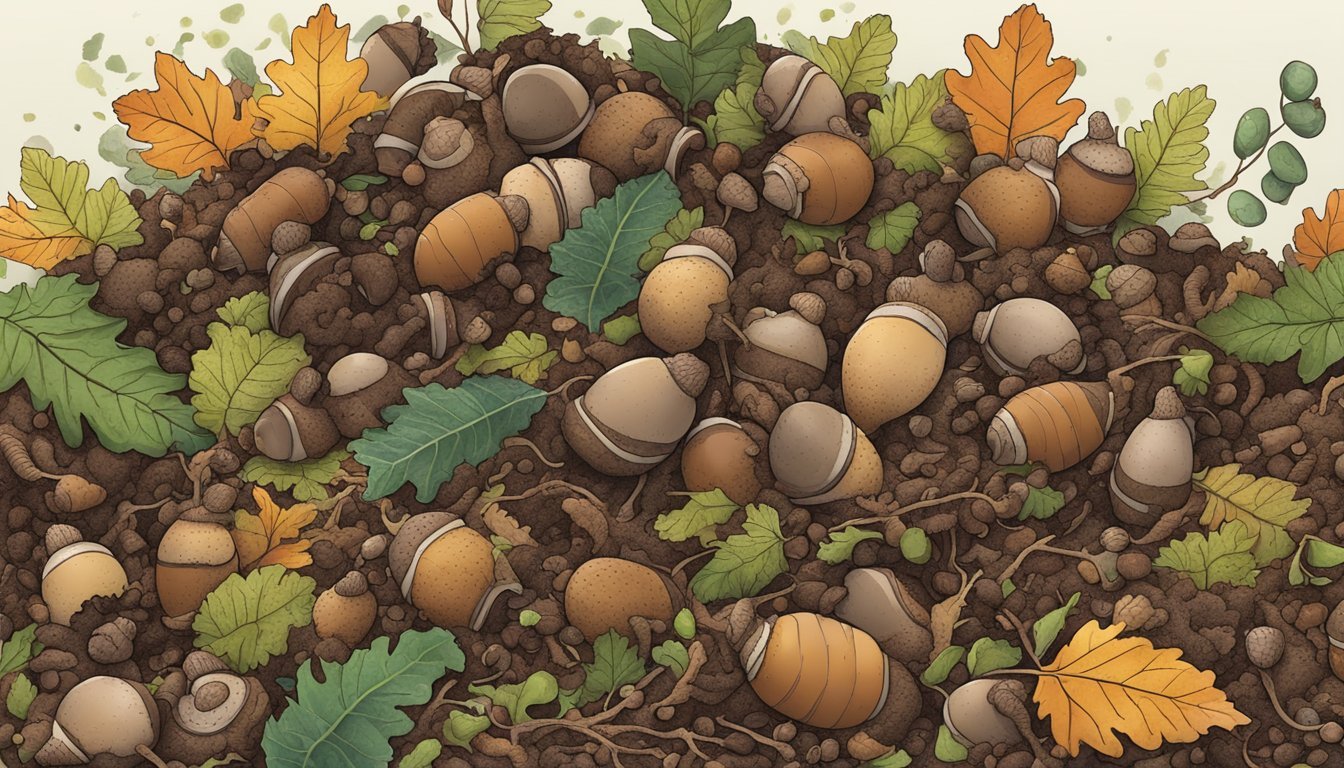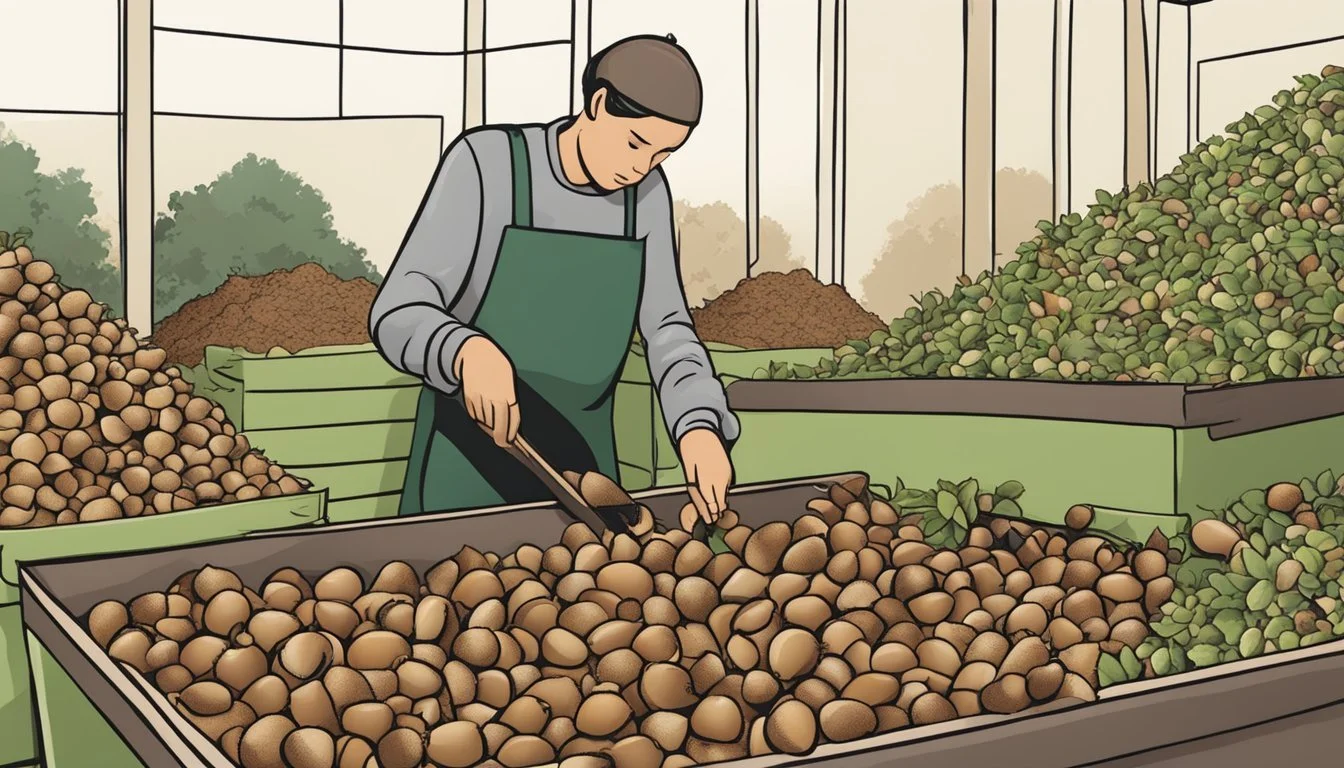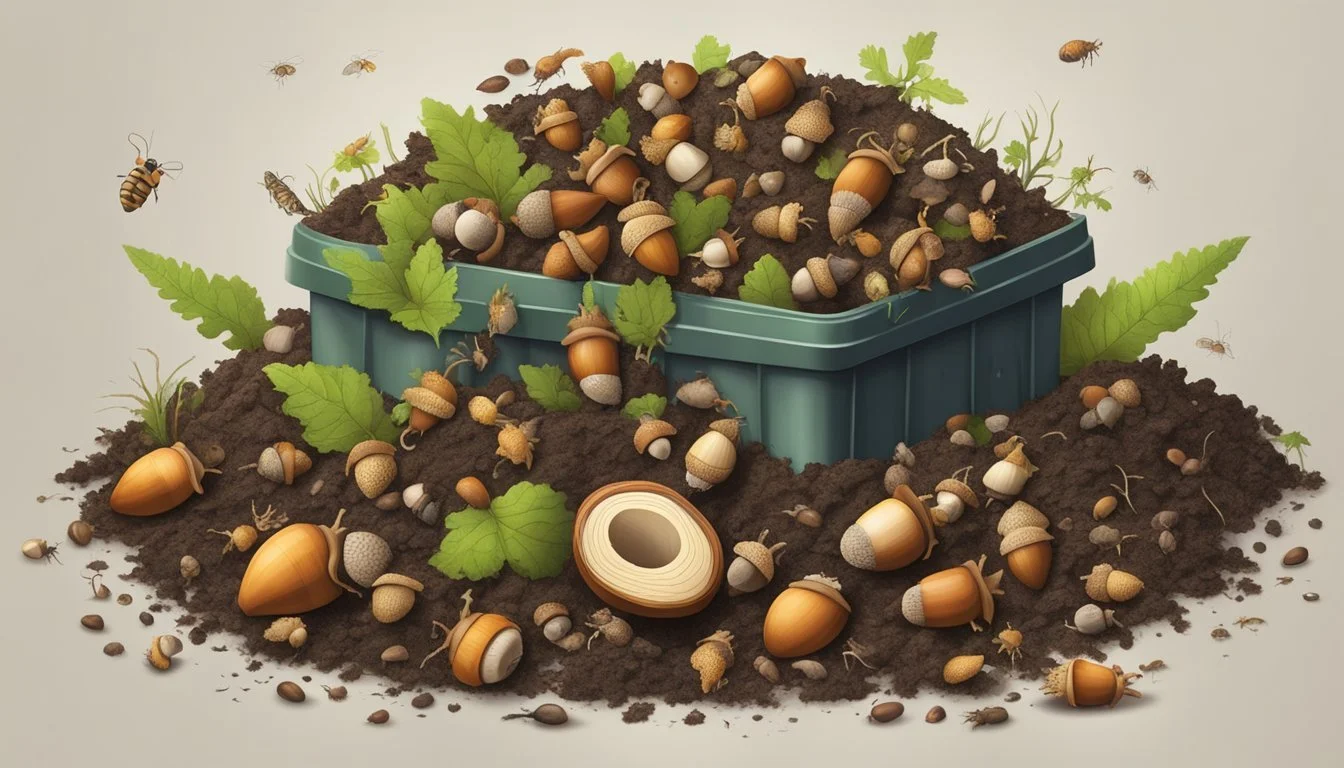Can You Compost Acorns?
Understanding Nut Decomposition in Composting
Acorns, the nut of oak trees, are often plentiful in yards and gardens during the fall season. As gardeners and environmentally-conscious individuals seek sustainable methods to manage organic waste, the concept of composting acorns arises. Composting serves as a natural process to convert organic materials into a nutrient-rich soil amendment, and incorporates a variety of green and brown matter, with leaves, food scraps, and yard waste being common components.
Including acorns in a compost pile contributes to this mix of materials, providing both nutrients and organic matter. Acorns contain tannins, which may take longer to break down than other organic materials, thus it's important to consider how to properly incorporate them into a compost pile to facilitate decomposition. Crushing or grinding the acorns into smaller pieces before adding them to the compost can expedite the breakdown process, ensuring they contribute effectively to the resulting compost without significantly delaying the overall composting timeline.
Understanding Composting Fundamentals
Composting is an environmentally friendly process that transforms organic matter into a nutrient-rich soil amendment. By understanding its principles and benefits, individuals can enhance soil quality and contribute to a sustainable cycle of growth and renewal.
Composting Process
Composting involves the breakdown of organic materials by microorganisms in the presence of air and moisture. This natural decomposition turns once-living items into compost, a soil conditioner teeming with beneficial microorganisms. Key steps in the process include:
Collection of organic waste such as food scraps, leaves, and yard trimmings.
Layering greens (nitrogen-rich materials) and browns (carbon-rich materials) to balance the compost's composition.
Maintaining optimal conditions by regularly turning the pile to aerate it, which accelerates decomposition.
Monitoring for sufficient moisture, ensuring the pile is damp but not overly wet.
The time it takes to produce usable compost can range from a few months to a couple of years, and varies based on factors such as material types, pile size, and environmental conditions.
Benefits of Composting for Soil
Compost contributes significant benefits to soil, including:
Improvement of soil structure: Compost helps to bind soil particles into aggregates, improving aeration and drainage.
Addition of vital nutrients: It introduces essential nutrients back into the soil. These nutrients, including nitrogen, phosphorous, and potassium, are slowly released, providing long-term nourishment to plants.
Enhancement of soil biodiversity: Adding compost boosts the number of beneficial microorganisms, which aid in nutrient cycling and disease suppression.
Environmental sustainability: Composting is an eco-friendly way to reduce waste by diverting it from landfills where it would decompose anaerobically, creating greenhouse gasses.
Incorporating compost improves the overall health and fertility of the soil, making it an invaluable practice for gardeners, farmers, and environmental stewards alike.
Selecting Appropriate Composting Materials
When creating a compost pile, one must achieve the right balance between green and brown materials to ensure efficient decomposition.
Green Materials and Nitrogen Content
Green materials are essential for providing nitrogen, a critical component that aids in the rapid growth of composting microorganisms. Items high in nitrogen include grass clippings and kitchen waste such as fruit and vegetable scraps.
Grass Clippings: Freshly cut grass is a potent source of nitrogen. It should be added in layers to prevent matting and to let air circulate.
Kitchen Waste: Fruit and vegetable scraps introduce necessary moisture and nitrogen. They should be buried within the compost to avoid attracting pests.
Brown Materials and Carbon Balance
Brown materials contribute carbon, which is necessary to balance the nitrogen in compost and create a hospitable environment for decomposing organisms. Critical brown materials include shredded newspaper, leaves, and—in the case of this article's context—acorns.
Shredded Newspaper: This material is a readily available carbon source that decomposes quickly. Shred it to improve breakdown and mix well with green materials to maintain airflow.
Leaves: Fallen leaves are an abundant carbon-rich resource. They should be mixed thoroughly to prevent matting and to aid in aeration.
Acorns: Although they break down slower due to their hardness, acorns are a valid brown material. Crushing them can hasten decomposition and prevent them from sprouting within the compost.
The Role of Acorns in Compost
In the composting process, acorns can be a beneficial addition due to their carbon-rich content and nutrient profile. They do, however, present certain challenges that require specific measures to ensure efficient decomposition.
Acorn Decomposition Rates
Acorns decompose at a slower rate than many other organic materials in a compost pile. This slower breakdown is attributed to their hard shells and high tannin content. The tannins, which are natural compounds found in oak trees, can inhibit growth in plants if they are present in high concentrations. Therefore, to facilitate a quicker decomposition process, it's recommended to:
Crush or grind acorns before adding them to compost
Soak them in water to help leach out tannins
Nutritional Value of Acorns
Acorns bring a significant amount of nutrients to compost. They contain:
Protein: Essential for plant growth
Fiber: Adds bulk and aids in soil aeration
Minerals: Including iron, potassium, calcium, magnesium, and phosphorus, which support various plant functions
When acorns decompose, these nutrients slowly release into the compost, enhancing its quality and providing a balanced nutritional profile for garden soil.
Challenges With Composting Acorns
One of the primary challenges when composting acorns is their potential to sprout if not treated properly before being added to the pile. Composters need to be mindful of:
Removing harmful tannins: Soaking acorns can reduce their tannin content, which otherwise might be detrimental to plant growth.
Preventing germination: Acorn shells protect the seed inside; grinding or crushing them prevents sprouting within the compost pile.
Ensuring that only acorns from pesticide-free areas are used to avoid chemical contamination.
Pre-Composting Treatments for Acorns
Before adding acorns to a compost pile, certain treatments can enhance their decomposition and mitigate potential issues. These treatments are particularly important for reducing tannin levels and facilitating the breakdown of the hard shells.
Reducing Tannin Levels
Acorns contain tannins, which can be harmful in large quantities and may inhibit plant growth. To lower tannin levels, one can soak acorns in water. This process involves:
Removing the caps from the acorns, if present.
Placing the acorns in a mesh bag or similar container.
Submerging the acorns in a large container of water.
Changing the water daily, until it remains clear, indicating most tannins have been leached out.
Mechanical Breakdown of Shells
The shells of acorns are notably hard and may require mechanical intervention to break them down:
Roasting: Gently roasting acorns in an oven can dry and brittle the shells, making them easier to break.
Crushing: One can use a hammer or similar tool to carefully crush the roasted acorns, improving their surface area and expediting decomposition.
It should be noted that these treatments will not only hasten the composting process but also prevent acorns from potentially sprouting within the compost pile.
Incorporating Acorns Into Your Compost
Acorns can enhance a compost pile with their nutrient content, but due to their hard shells, they require specific steps for efficient decomposition. Proper layering, moisture control, and aeration are crucial for integrating acorns successfully into compost.
Layering Your Compost Pile
One should arrange their compost pile in alternating layers of green and brown materials. Acorns, classified as a brown material due to their carbon content, should be interspersed with green materials rich in nitrogen like kitchen scraps or grass clippings. A balanced approach to these layers aids in efficient decomposition. The recommended ratio is 3 parts brown to 1 part green.
Example Layering Sequence:
Bottom layer: Twigs or straw for aeration
Next layer: Green materials (e.g., vegetable scraps)
Following layer: Crushed acorns
Repeat layering, finishing with a brown layer on top
Monitoring Moisture and Aeration
Maintaining the right level of moisture is essential; the pile should be damp but not soggy. If acorns are present, one may need to water the pile more frequently as they can absorb significant amounts of moisture. For aeration, using a shovel or rake to regularly turn the pile is advised. This process introduces oxygen, which is pivotal for the microbes responsible for decomposition.
Moisture Check:
Squeeze a handful of compost material
Aim for a wrung-out sponge's moisture level—damp but not dripping
Turning and Mixing the Compost
Every few weeks, one should turn the compost pile to expedite the decomposition of acorns. A garden fork or shovel works well for this purpose. The goal is to move the materials from the center of the pile to the outside, and vice versa. This mixing also redistributes moisture and heat, which are essential for breaking down the tough shells of acorns.
Mixing Tools:
Shovel or garden fork
Optional: Tarp to help with the turning process if the pile is large
By following these specific steps, acorns can be successfully included in your compost, gradually transforming into a rich, nutrient-dense soil amendment.
Advantages of Acorn Compost
Integrating acorns into compost provides several benefits ranging from enhancing soil nutrition to supporting local ecosystems. These advantages make acorns a valuable addition to composting practices.
For Your Garden
Acorn compost can improve soil structure, increasing its ability to retain water and air, which benefits root development. Gardens with acorn-rich compost can experience improved soil fertility over time as the acorns decompose, gradually releasing nutrients.
Enriching Plant Food
Acorns contain essential nutrients that, when broken down in compost, become part of a rich plant food. This compost acts as a slow-release fertilizer providing nitrogen, potassium, and phosphorous - essential elements for healthy plant growth.
Wildlife Benefits
Composting acorns can inadvertently support local wildlife, such as squirrels, who may find and feed on them before they fully decompose. Additionally, when used in the garden, acorn compost can attract beneficial insects and promote biodiversity.
Environmental Impact
The process of composting acorns helps reduce organic waste in landfills and minimizes the environmental footprint. By incorporating natural composting materials like acorns into compost, individuals contribute to a cycle of sustainability, enhancing the local ecosystem's health.
Practical Tips and Considerations
When composting acorns, one must consider site selection, seasonal adjustments, and effective troubleshooting to ensure a successful composting process.
Choosing the Right Composting Site
The choice of site is crucial for composting acorns. One should look for a spot that's away from daily activity to avoid interference but still easily accessible for maintenance. Key factors include:
Proximity to landscaping: Keep the compost a good distance from your garden to avoid any unwanted sprouting of oak trees.
Surface: A flat and well-drained area prevents waterlogging. If necessary, lay down a tarp to protect surfaces like driveways from decomposing material.
Composting in Different Seasons
Composting acorns can be affected by seasonal changes. Acorns decompose more slowly in colder months due to reduced microbial activity. To compensate:
Winter: Insulate the compost pile with tarps or straw to retain heat.
Summer: Monitor moisture levels more closely and turn the pile regularly to aid decomposition.
Troubleshooting Common Issues
If one encounters problems during the composting process, it's essential to address them promptly. Common issues include:
Odors: This can indicate excess moisture. Turn the pile to introduce air and adjust the green-brown matter ratio.
Pests: To discourage animals, ensure acorns are well-covered by other compost material.
By adhering to these practical tips and considerations, composting acorns can be a smooth and environmentally friendly practice.
Composting Acorns and Community Engagement
Involving the community in composting acorns can enhance environmental sustainability and foster a collaborative spirit. Education plays a pivotal role in the success of these initiatives, while sharing best practices and spearheading local programs can yield significant benefits.
Education and Sharing Best Practices
Communities that prioritize education about composting can turn acorn disposal from a chore into a collective eco-friendly project. By developing content for workshops and online apps, they can demonstrate how acorns, despite their hard shells, contribute valuable nutrients to compost. They can highlight methods such as:
Grinding acorns to speed up decomposition.
Balancing green and brown materials in compost to optimize the carbon-to-nitrogen ratio.
Furthermore, sharing success stories through community forums or social media can inspire homeowners to partake in composting acorns, spreading knowledge on best practices effectively.
Local Composting Initiatives
Local governments and organizations can establish composting initiatives that encourage the participation of community members. They can set up designated composting sites where residents can bring acorns and other compostable materials. Other initiatives may include:
Collection drives during peak acorn fall seasons.
Compost bin distribution to promote at-home composting efforts.
These initiatives not only manage waste but also educate residents about the ecological benefits of composting acorns. They foster a sense of responsibility and community engagement, ultimately enriching the local environment.







